Introduction

When it comes to weight loss, it’s not just about what you eat but also how much you eat. Portion control is a crucial element in managing your daily caloric intake, and making mistakes in measuring your portions can hinder your weight loss progress. Whether you’re just starting out or have been on the weight loss journey for a while, avoiding common portion measuring mistakes can help you achieve your desired results. In this article, we’ll be discussing some of the most common portion measuring mistakes and how to avoid them step-by-step.
Why Portion Control is Important
Maintaining proper portion control is an important aspect of a healthy lifestyle. When it comes to weight loss, portion control is essential because it helps you consume fewer calories and promotes a balanced diet. Here are some reasons why you should pay attention to your portion sizes:
- Prevents Overeating: When you control your portion sizes, it prevents you from consuming more calories than your body needs, which can lead to weight gain.
- Boosts Metabolism: Eating smaller, well-proportioned meals throughout the day can help keep your metabolism active, aiding in weight loss.
- Helps in Maintaining Balanced Diet: Portion control encourages you to include a variety of foods in your diet, which can ensure that you are getting all the essential nutrients that your body needs.
- Reduces the Risk of Chronic Disease: Consuming large portion sizes over a long period of time can lead to obesity, which is linked to many chronic diseases such as diabetes, heart disease, and cancer.
- Promotes Mindful Eating: Portion control involves being mindful of what you eat and how much you eat. This can help you develop a healthy relationship with food and prevent emotional eating.
By incorporating portion control into your daily routine, you can make significant progress towards achieving a healthy weight and lifestyle.
Consuming Too Much or Too Little
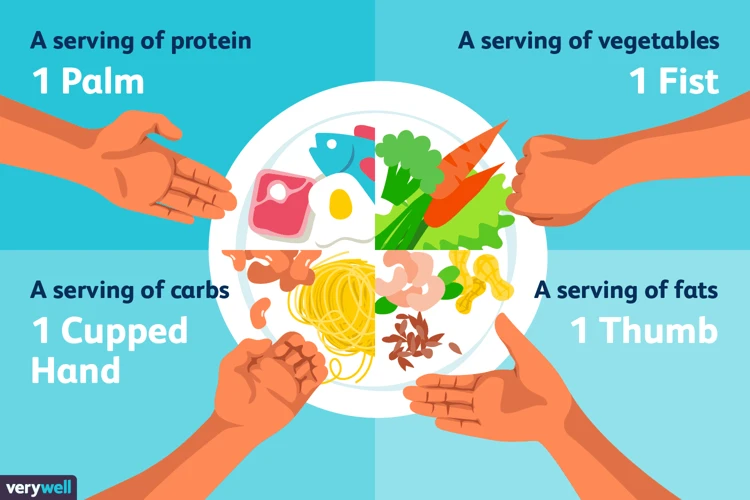
One of the biggest challenges people face when it comes to weight loss is finding the right balance between consuming too much or too little food. Both scenarios can have negative impacts on your weight loss goals and overall health. It’s crucial to be mindful of the portion sizes you’re consuming. Unfortunately, many people make common portion measuring mistakes that can hinder their progress. In this section, we’ll discuss some of these mistakes and how to avoid them.
Not Using Measuring Tools
One common portion measuring mistake that people make is not using measuring tools. Eyeballing portion sizes can be incredibly inaccurate, leading to overestimating or underestimating your caloric intake. By not using measuring tools, you could be consuming far more or less than you intended, derailing your weight loss progress.
To avoid this mistake, invest in some measuring tools such as measuring cups, spoons, and kitchen scales. When measuring liquid ingredients, use a liquid measuring cup with clearly marked measurements. Dry ingredients should be measured using dry measuring cups and spoons, which are specifically designed for that purpose. Measuring by weight with a kitchen scale is also a great way to get a more accurate measurement, particularly for items with irregular shapes or sizes.
By incorporating measuring tools into your meal planning and preparation, you will be able to more accurately measure and track your caloric intake, helping you reach your weight loss goals.
Eating Out of the Container
When it comes to portion control, eating out of the container can be a major stumbling block. It’s easy to mindlessly eat an entire bag of chips or pint of ice cream when you’re scooping it directly out of the container. Here are some tips to help you avoid this common mistake:
| TIP: | Avoid eating straight from the container. Instead, portion out an appropriate serving size and put it on a plate or in a separate dish. |
| TIP: | If you’re craving a treat that comes in a large container, like a carton of ice cream, consider buying individual servings or pre-portioning the container yourself. |
| TIP: | Be mindful of your surroundings when you eat. Mindlessly snacking while watching TV or working on the computer can lead to overeating, especially when you’re eating out of a container. |
By following these tips, you can avoid mindless eating and make sure you’re portioning out the right amount of food. Remember, every little bit counts when it comes to weight loss and overall health.
Mindless Eating
Mindless eating is a common mistake that most of us commit while managing our portions for weight loss. Eating while being distracted or stressed, can lead to overeating as we are not paying attention to our body’s signals of fullness. To avoid this mistake, try to make sure you are eating without distractions like scrolling through your phone or watching TV. Here are some ways to avoid mindless eating:
- Eat slowly: Eating slower can help you enjoy your food and also give your body time to register when it is full.
- Use smaller plates: Using smaller plates can create the illusion of a full plate which can help you feel satisfied with a smaller portion size.
- Practice mindful eating: Mindful eating is a technique where you pay attention to the tastes, textures, and smells of your food. This can help you be more present while eating and avoid mindlessly consuming large portions.
- Eliminate distractions: Try to eat without any distractions like TV or your phone as it can distract you from paying attention to the amount of food you are consuming.
- Portion out your food: Portioning out your food can help you avoid overeating and give you a better idea of how much you are consuming.
By avoiding mindless eating practices and being mindful of your eating habits, you can better control your portions for weight loss.
Not Accounting for Serving Size Differences
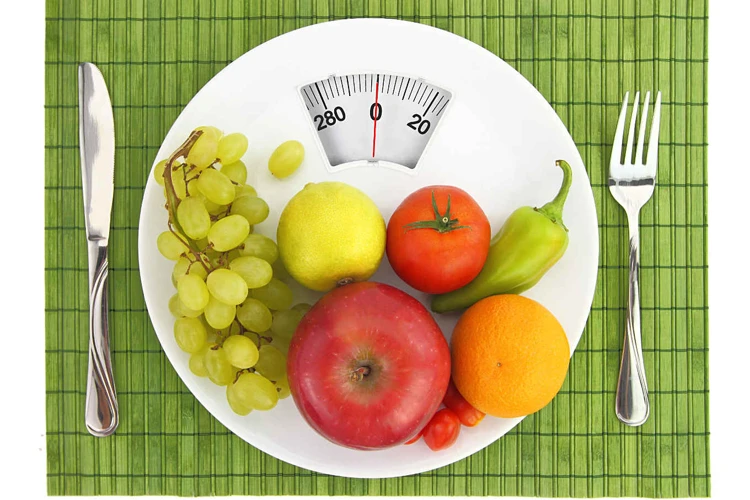
One important aspect of successful portion control is paying attention to serving sizes. However, many people make mistakes when trying to measure their food intake due to a lack of awareness of how serving sizes can differ. It is crucial to understand the factors that affect serving sizes to effectively manage portions and achieve weight loss goals. Let’s explore some common mistakes people make when it comes to accounting for serving size differences.
Reading Labels Incorrectly
One of the most important things to keep in mind when it comes to portion control is the serving size. Many people make the mistake of reading labels incorrectly which leads to consuming more than the correct portion size.
Here are some common mistakes people make when reading labels:
- Not paying attention to the serving size – the serving size is often less than what people typically eat
- Confusing the serving size with the number of servings per package – this can lead to consuming more than intended
- Not taking into account the calories from multiple servings – many packaged foods contain multiple servings which can add up quickly
- Focusing solely on the calorie count and not looking at other important nutrients – this can lead to an unbalanced diet
It’s important to take the time to read and understand the labels on packaged foods. Pay attention to the serving size, number of servings per package, and the nutrient breakdown. This can help you make better choices and avoid consuming more than intended.
Confusing Different Types of Measurements
One common portion measuring mistake is confusing different types of measurements. With so many measurement terms being thrown around in recipes and on food labels, it can be easy to mistake one for another. Here are some common measurement terms and what they mean:
- Weight: the mass of an item, usually measured in grams or ounces. This is often used for meat or other protein sources.
- Volume: the amount of space an item takes up, usually measured in milliliters or cups. This is often used for liquids and some dry ingredients.
- Count: the number of items, such as individual fruits or vegetables, that make up a serving size.
It’s important to pay close attention to the type of measurement being used in a recipe or on a food label. For example, if a recipe calls for 8 ounces of chicken breast, you’ll need to use a kitchen scale to measure out the correct weight. But if a recipe calls for 1 cup of chopped vegetables, you’ll need to use a measuring cup to get the right volume.
Another common mistake is confusing fluid ounces (oz. fl.) with ounces (oz.) on food labels. Fluid ounces are a measurement of volume, while ounces are a measurement of weight. This means that a product may have the same number of fluid ounces as weight ounces, but those ounces would represent different amounts of the product. Always check the label for serving sizes and use the appropriate measuring tools to get an accurate portion.
Overestimating Food Portion Sizes
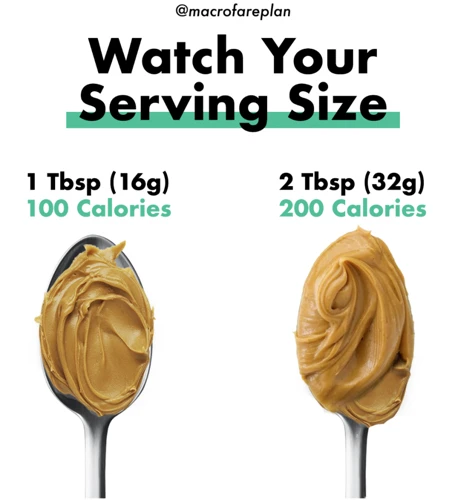
When it comes to weight loss, it’s common to think that eating less of everything is the key. However, overestimating the portion sizes of your food can be just as damaging as eating too much of it. It’s not always easy to accurately measure out your food, especially when you are eating out or cooking for multiple people. But, by not understanding what a serving size looks like or failing to account for small additions like condiments, you could be consuming way more calories than you realize. In this section, we’ll explore some of the most common mistakes people make when it comes to overestimating their food portions and how to avoid them.
Not Understanding What a Serving Size Looks Like
It can be difficult to know exactly what a serving size looks like and this can lead to overestimating or underestimating portions. Portion control can only be effective if you actually know how much you’re consuming. Many people think they are eating an appropriate amount, but in reality, they are consuming much more than they think. To avoid this mistake, it’s important to use measuring tools and understand what a serving size looks like for different types of food.
One way to educate yourself on serving sizes is to check the nutrition label on the package. This will typically list the serving size and the number of servings in the package. However, it’s important to remember that the serving size listed may not be the same as the portion size you typically consume. It’s crucial to use measuring tools to get a more accurate idea of how much you are eating.
Another helpful tool is to use an online calculator or guidebook to determine serving sizes for different types of food. These resources can be especially useful for whole foods, such as fruits and vegetables, where there may not be a label with serving size information.
To further help you understand serving sizes better, take a look at the following table which provides approximate portion sizes for different food categories:
| Food Category | Serving Size |
|---|---|
| Protein (meat, poultry, fish, tofu) | 3 oz (about the size of a deck of cards) |
| Grains (rice, pasta, bread) | 1 oz (about the size of a matchbox) |
| Nuts and Seeds | 1 oz (about a handful) |
| Fruits | 1 medium piece or 1 cup chopped |
| Vegetables | 1 cup raw or 1/2 cup cooked |
| Dairy (milk, cheese, yogurt) | 1 cup (milk), 1 oz (cheese), 6 oz (yogurt) |
By understanding what a serving size looks like and measuring your portions accordingly, you can help ensure that you are consuming an appropriate amount of food for your weight loss goals.
Not Accounting for Condiments and Toppings
When it comes to measuring portions for weight loss, many people tend to overlook the impact that condiments and toppings can have. These small additions can add up quickly in terms of calories and can easily derail weight loss efforts. One tablespoon of mayonnaise, for example, can contain up to 90 calories and 10 grams of fat. To avoid this common portion measuring mistake, it is important to account for these extra toppings and condiments.
One useful way to keep track of these added calories is to create a separate category for condiments and toppings in your food journal or calorie tracking app. Then, when measuring your meals, be sure to include any additional toppings or condiments in your calculation. Using measuring spoons or a food scale to portion out these additions can also help you to stay on track.
Below is a table that shows the calorie content of common condiments and toppings:
| Condiment/Topping | Serving Size | Calories |
|---|---|---|
| Mayonnaise | 1 tbsp | 90 |
| Ketchup | 1 tbsp | 20 |
| Barbecue Sauce | 1 tbsp | 30 |
| Sour Cream | 1 tbsp | 26 |
| Butter | 1 tbsp | 102 |
| Cheddar Cheese | 1 oz | 114 |
| Croutons | 1/2 cup | 57 |
| Bacon Bits | 1 tbsp | 30 |
By being mindful of the calorie content of toppings and condiments, you can more accurately measure your portions and stay on track with your weight loss goals.
Not Adjusting for Cooked vs Raw Measurements
One common portion measuring mistake for weight loss is not adjusting for cooked vs raw measurements. This error can lead to under or overestimating calorie intake, ultimately derailing weight loss efforts. It’s important to understand that the weight and volume of food can change significantly during the cooking process due to water loss and absorption.
To avoid this mistake, here is a table that shows cooked vs raw measurements for common foods:
| Food | Raw Amount | Cooked Amount |
|---|---|---|
| Chicken Breast | 4 oz | 3 oz |
| Brown Rice | 1/2 cup | 1 cup |
| Broccoli | 1 cup | 1/2 cup |
As seen in the table, the cooked amount of chicken breast is less than the raw amount, while the cooked amount of brown rice is greater than the raw amount. It’s important to measure food AFTER cooking to ensure accurate portion control.
In addition to measuring after cooking, another way to avoid this mistake is to use online resources that provide cooked nutrition information for different foods. The USDA National Nutrient Database is a great resource for this information. By adjusting for cooked vs raw measurements, you can ensure that you are accurately tracking your calorie intake and reaching your weight loss goals.
Underestimating Food Portion Sizes
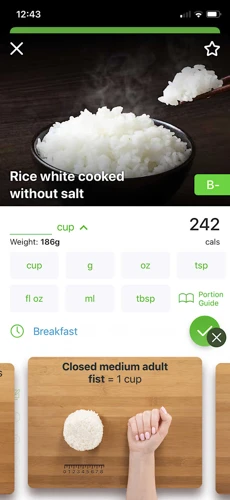
It can be frustrating to put in effort to measure your portions and still not see the results you desire. You may think you’re being conscious of serving sizes, only to find out that you’re underestimating how much you’re consuming. This can sabotage your weight loss goals and leave you feeling disheartened. In order to prevent underestimating your food portion sizes, it’s important to pay close attention to certain factors that contribute to this common mistake. Let’s explore some common reasons why people tend to underestimate the amount of food they’re consuming.
Not Measuring High Calorie Foods
One common portion measuring mistake that people make is not measuring high calorie foods. This can be a serious problem because these types of foods are often very dense in calories, meaning that even a small portion can pack a big caloric punch. Here are some examples of high calorie foods that people often underestimate:
- Nuts and seeds: These may seem like a healthy snack, but they are often very calorie-dense. For example, just a small handful of almonds (around 14 nuts) can contain over 100 calories, and many people eat much more than that.
- Cheese: This is another food that people often eat in much larger portions than they realize. One ounce of cheddar cheese (around the size of a matchbox) contains around 114 calories, but many people will eat several ounces at once.
- Oils and fats: These are some of the most calorie-dense foods out there. Just one tablespoon of olive oil contains around 120 calories, and many recipes call for several tablespoons.
- Desserts: Of course, most people know that desserts can be loaded with calories. However, even seemingly “small” treats like a single scoop of ice cream or a small slice of cake can add up quickly.
If you’re trying to lose weight, it’s important to measure out these types of high calorie foods carefully. Using a food scale or measuring cups and spoons can help you get a better handle on how much you’re actually eating. Remember, even just a few extra bites each day can add up over time and stall your progress.
Not Measuring Caloric Beverages
One common mistake people make when it comes to portion control is not measuring their caloric beverages. It’s easy to overlook the fact that drinks like soda, juice, and alcohol can contribute a significant amount of calories to your overall daily intake. Here are some reasons why you should be measuring your caloric beverages:
- Calorie Content: Many caloric beverages contain a high amount of calories, and it’s easy to consume more than you realize if you don’t measure them properly.
- Lack of Satiety: Unlike solid foods, liquid calories don’t provide the same satiety signals to your brain. This means that you can consume a lot of liquid calories without feeling full, leading to overconsumption.
- Added Sugars: Many caloric beverages contain added sugars, which can lead to weight gain and other health issues if consumed in excess.
Measuring your caloric beverages can help you become more aware of how much you’re consuming and make it easier to adjust your overall calorie intake as needed. Use a measuring cup or food scale to accurately measure the amount of liquid you’re consuming. Avoid drinking out of large cups or using visual estimates, as these methods can lead to inaccuracies in your portion control efforts.
Not Adjusting Portion Sizes for Your Specific Needs
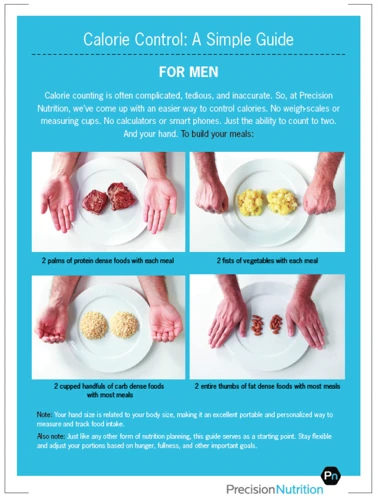
When it comes to portion control, it’s not just about measuring and estimating the right amount of food. It’s also important to tailor your portions to your unique needs. Failing to adjust your portion sizes could mean consuming too many or too few calories, which can hinder your weight loss or even lead to weight gain. Let’s explore some common mistakes people make when it comes to portion control and how to avoid them by adjusting your portions to your specific needs.
Not Accounting for Physical Activity Levels
One common mistake that people make when it comes to portion control is not accounting for their physical activity levels. This can have a significant impact on the number of calories needed to maintain a healthy weight.
To better understand this concept, consider the following table:
| Physical Activity Level | Description | Recommended Daily Caloric Intake |
|---|---|---|
| Sedentary | Little to no exercise or physical activity | 1,600-2,000 calories/day (for women), 2,000-2,400 calories/day (for men) |
| Moderately Active | Regular exercise or physical activity (e.g. walking, biking, or swimming, approximately 30 minutes per day) | 1,800-2,200 calories/day (for women), 2,200-2,600 calories/day (for men) |
| Active | Regular intense exercise or physical activity (e.g. running, weight lifting, or HIIT workouts, approximately 60 minutes per day) | 2,000-2,400 calories/day (for women), 2,400-2,800 calories/day (for men) |
| Very Active | Regular intense exercise or physical activity (e.g. training for a marathon or triathlon, approximately 2 hours per day) | 2,400-2,800 calories/day (for women), 2,800-3,200 calories/day (for men) |
As you can see, the more physically active a person is, the more calories they need to consume to maintain their weight. This means that if someone is not taking their physical activity level into account when measuring their food portions, they could be consuming too many calories, which can lead to weight gain.
It is important to not only measure your portions carefully but also to adjust your calorie intake based on your physical activity level. This can help ensure that you are providing your body with the right amount of fuel it needs to perform at its best without overconsuming and potentially gaining weight.
Not Adjusting for Muscle Mass
One common mistake people make when it comes to portion control for weight loss is not adjusting their portions based on their muscle mass. It is essential to understand that muscles require more energy (calories) to maintain than fat. Individuals with a higher amount of muscle mass need to consume more calories to maintain their weight compared to those with less muscle mass. On the other hand, those with less muscle mass need to consume fewer calories to avoid gaining weight.
Here are some tips on how to adjust your portions based on your muscle mass:
- Calculate your basal metabolic rate (BMR). This is the number of calories your body burns at rest to maintain vital body functions such as breathing and circulation.
- Determine your activity level. People who are more active burn more calories than those who lead a sedentary lifestyle.
- Take into consideration your muscle mass. As mentioned earlier, individuals with higher muscle mass require more calories to maintain their weight.
- Adjust your caloric intake based on your goals. If you want to lose weight, reduce your calorie intake slightly. If you want to maintain your weight, consume the same amount of calories as your BMR. If you want to gain weight (muscle mass), increase your calorie intake slightly.
Keep in mind that it is important to fuel your body with the right nutrients, including protein, carbohydrates, and healthy fats, to support muscle growth and recovery. Make sure to adjust your portion sizes accordingly to meet your body’s needs. By taking your muscle mass into account, you can ensure that you are consuming the right amount of calories to support your weight loss or gain goals.
Using the Wrong Portion Control Techniques
Ensuring proper portion control is crucial for any weight loss journey. However, it’s important to note that not all portion control techniques are created equal. Some methods may seem effective but can actually hinder your progress. Using incorrect portion control techniques can be detrimental to your weight loss efforts, and can even lead to weight gain if you are unknowingly consuming an incorrect amount of food. In this section, we will discuss some common mistakes people make when trying to control their portions and give you tips on how to avoid them.
Using Your Hands for Portion Control
One common but not always accurate method for portion control is using your hands. Your hand can give you a rough estimate of different serving sizes depending on the food. However, it’s important to keep in mind that hand size varies from person to person, so it’s not a one-size-fits-all method.
Pros:
- Easy method that does not require measuring tools
- Can be used anywhere
- Provides a rough estimate of serving sizes
Cons:
- Hand size varies from person to person
- Can vary based on the type of food being measured
- Not as accurate as measuring tools
It’s important to use caution when using your hands for portion control. For example, using your fist as a measurement for vegetables might not be appropriate for all vegetables. Some vegetables may be denser than others, and therefore require a larger or smaller portion size.
Additionally, using your hand for measuring calorie-dense foods like nuts or cheese may not provide an accurate portion size. These types of foods are easy to overeat, and it’s important to use measuring tools for accuracy.
Using your hands for portion control may be a convenient method, but it’s important to recognize its limitations and use measuring tools when necessary for greater accuracy.
Not Pre-Portioning Your Food
One common mistake people make when trying to control their portions is failing to pre-portion their food. This means that they do not measure or divide the food into appropriate serving sizes before consuming it. Pre-portioning your food is crucial if you want to lose weight because it helps you better manage your calorie intake.
In order to pre-portion your food, you will need to make use of measuring tools such as a food scale, measuring cups, and spoons. These tools are essential in helping you measure the exact amount of food you need to consume for a meal. Additionally, they also help you avoid underestimating or overestimating the serving size of your food, which can lead to overeating and hinder your weight loss goals.
One helpful tip is to pre-portion your snacks into individual servings in advance. For example, you can portion your nuts into small bags or your vegetables into small containers to have ready-to-eat snacks on hand. Pre-portioning your snacks ensures that you are not mindlessly consuming food and helps you stick to your desired calorie intake for the day.
Another way to pre-portion your food is by dividing your meals into separate servings before serving yourself. You can use measuring cups or a food scale to portion out the correct amount of protein, carbohydrates, and vegetables onto your plate. This method helps you avoid the temptation of going back for seconds or consuming larger portions than necessary.
By pre-portioning your food, you are giving yourself the opportunity to be in control of your food intake, which is key in losing weight or maintaining a healthy lifestyle. Remember to always use measuring tools and divide your meals into appropriate serving sizes to help you stay on track with your goals.
Conclusion
In conclusion, maintaining a healthy weight is crucial for overall physical and mental health. One effective strategy for weight management is portion control. However, there are common mistakes that people make when measuring their food portions that can hinder weight loss efforts.
One key mistake is not using measuring tools such as a food scale, measuring cups, or spoons. Eyeballing portions can lead to inaccurate measurements and ultimately consume more calories than intended.
Eating out of the container is another mistake that can lead to overeating. It’s easy to lose track of how much has been eaten when the food is in a large container.
Mindless eating is a common issue people face, especially when consuming snacks or watching TV. It’s essential to be present and mindful when eating, which allows for better portion control.
Additionally, it’s important to understand the serving size and serving size differences of various food items. Reading labels correctly and understanding different types of measurements can help with accuracy when measuring portions.
Overestimating portion sizes can also hinder weight loss efforts. Not understanding what a serving size looks like or not accounting for condiments and toppings can lead to consuming more calories than intended. Additionally, not adjusting for cooked versus raw measurements could lead to inaccurate portion sizes.
On the other hand, underestimating portion sizes can also be an issue. Not measuring high-calorie foods, such as oils or nuts, can lead to consuming excess calories. The same is true with caloric beverages, such as soda or juice.
Lastly, adjusting portion sizes for one’s specific needs is crucial. Not accounting for physical activity levels or muscle mass can lead to consuming too many or too little calories. Additionally, using the wrong portion control techniques can negatively impact weight loss efforts.
In summary, avoiding common portion measuring mistakes is critical for effective weight loss. Using measuring tools, being mindful while eating, understanding serving sizes, and accounting for one’s specific needs are all key factors to consider when practicing portion control for weight management.
Frequently Asked Questions
How can portion control benefit weight loss?
Portion control can help manage the number of calories consumed and ensure you are not overeating, leading to weight loss.
What measuring tools can I use for portion control?
You can use measuring cups, spoons, food scales, or even smartphone apps to measure portions accurately.
Is it bad to eat out of the container?
Yes, eating out of the container can lead to mindless eating and overeating, making it more challenging to control portions and lose weight.
Can I trust serving sizes listed on food labels?
Yes, food labels provide accurate serving sizes, but it’s essential to realize that a serving size may differ from an individual’s caloric requirement, which means it may be necessary to adjust portion sizes accordingly.
What is the difference between portion and serving sizes?
A portion size is the amount of food an individual chooses to eat, while a serving size is the recommended amount of food for that particular type of food or drink.
Can I adjust portion sizes based on my activity level?
Yes, individuals with a more active lifestyle may require more significant portions than those with a more sedentary lifestyle.
What are high calorie foods that need to be measured?
High-calorie foods that should be measured include nuts, seeds, oils, and cheese.
Can I use my hands for portion control?
While using hands is not the most accurate method of measuring portions, it can be a quick and easy way to estimate portion sizes.
Why is pre-portioning food helpful for weight loss?
Pre-portioning food helps avoid mindless eating and overeating, plus it can help manage calorie intake and promote weight loss.
Is it essential to adjust portion sizes for cooked vs. raw measurements?
Yes, it’s essential to adjust portion sizes to account for the difference in weight and volume between cooked and uncooked foods.







